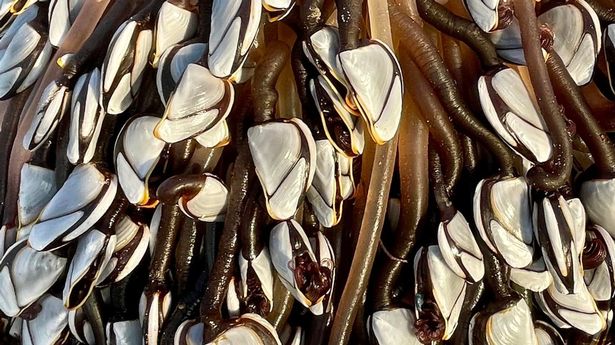Photographer Dave McGirr discovered the “extraordinary” white-shelled objects to a 20ft tree trunk washed upon the beach as he went for a walk. He was amazed at the value of the sea creatures

Image: Dave McGirr/SnapHappyDave)
A dog walker found ‘alien-like’ creatures worth £1,000s washed up on Welsh beach.
Dave McGirr, who was on holiday at the time, discovered the “extraordinary” white-shelled objects to a 20ft tree trunk washed up as he went for a walk.
His first instinct was to snap the “peculiar” driftwood castaways on camera as he is a keen photographer.
He then Googled the phenomenon and the results left him astonished.
Dave told NorthWalesLive : “I found out they are Gooseneck barnacles, described as rare ‘alien-like’ sea creatures.
“They are said to be a delicacy, selling for more than £80 a kilo.”
(
Image:
Getty Images)
Further research revealed another person had come across a similar driftwood find in Caernarfon two years ago.
It was covered with around 2,000 barnacles and said to be worth a small fortune.
Photo comparisons of the two finds suggests the haul, from Criccieth beach in Gwynedd, is the larger of the two.
By then, Dave had moved on to Snowdonia and he hasn’t been back to discover if anyone has claimed the seaside goldmine.
He said: “At the time I posted the photos on Facebook without thinking them particularly newsworthy.
(
Image:
Dave McGirr/SnapHappyDave)
But he was, anxious “not to create a stampede” over their value.
The rare species of barnacle are a delicacy in countries such as Portugal and Spain where they are known as percebes.
Export prices of up to £300 per kilo have been reported, though they can now be bought fresh online for around £80-£90 per kilo – or cheaper if frozen.
Depending on size, they fetch about £2 each, making Dave’s find worth around £3,000-£5,000.
The taste is said to resemble a cross between lobster and clam, with a texture similar to octopus.
(
Image:
Dave McGirr/SnapHappyDave)
Traditionally gathered from underwater rocks and crevices on Spain’s Costa da Morte, or Coast of Death, they are among the world’s most expensive seafoods.
The price reflects the dangers involved in gathering them by Percebeiros – specialist Gooseneck barnacle fishermen who risk their lives diving beneath crashing waves.
Dave’s photos created a frisson of excitement on social media.
“Aliens have landed!!” said one woman. Others urged him to “get collecting!”.
Dave, a retired sales manager from south Staffordshire, has a caravan nearby and is a regular visitor to the area.
(
Image:
Getty Images)
Despite his love of the area, he’d be reluctant to sample the fruits of his beach discovery.
He said: “When you get close, you can see they are like small octopuses, or squid.
“They have tiny tentacles that reach out from their shells. I’ve never tried eating them and, having now seen them, I’m not sure I’d want to try.”
Before it was realised that birds migrate, it was believed that barnacle geese hatched from Goose barnacles – smaller cousins of Gooseneck barnacles – as the birds were never seen to nest in Britain.
(
Image:
Dave McGirr/SnapHappyDave)
These barnacles were often found on driftwood, so it was thought they were attached to branches that had fallen into the sea.
Naturalists of the time noted similarities in colour and shape between barnacles and geese and so both assumed related names.
At fault is probably Gerald of Wales, archdeacon of Brecon, a noted traveller and writer.
In his 1188 tome Topographia Hiberniae, he referred to a “barnakle tree, or a tree bearing geese”.
Since barnacle geese were thought to be “neither flesh, nor born of flesh”, they could be eaten on fasting days when eating meat was forbidden by Christianity.
Read More
Read More
Read More
Read More
Read More
Views: 0









